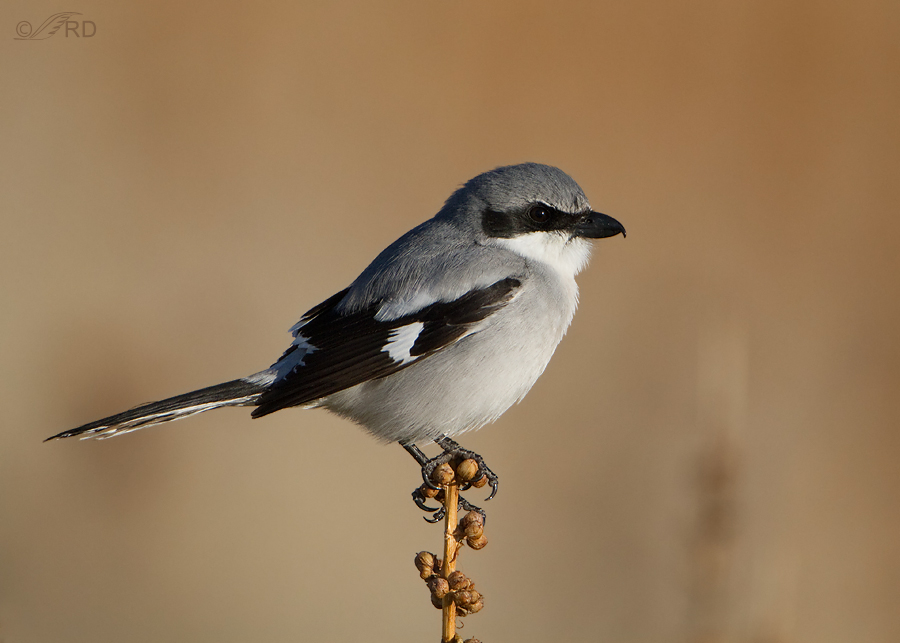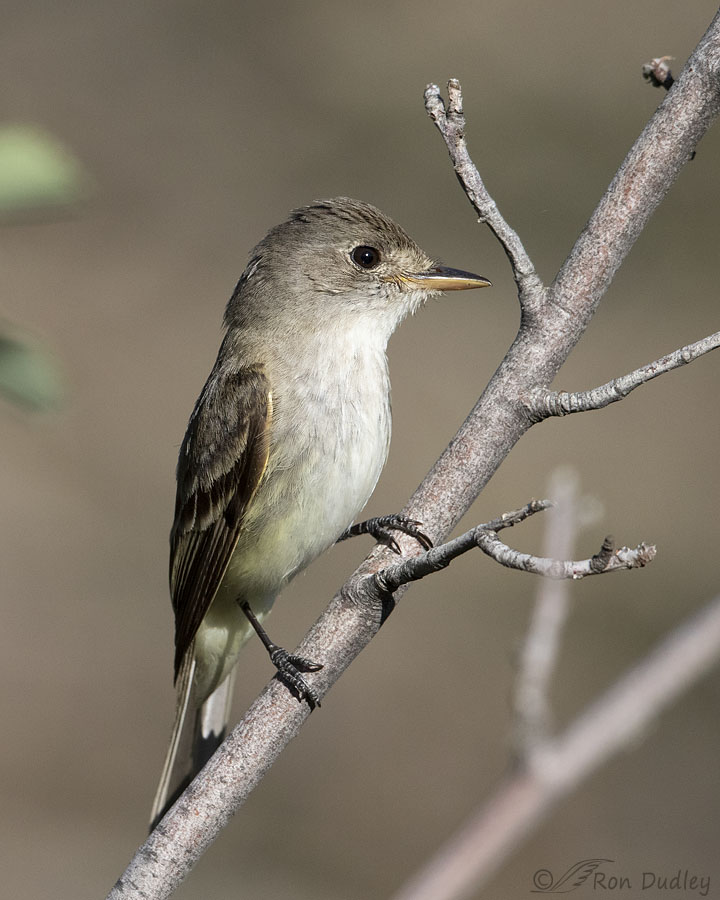A rose by any other name…
In the 16th century a “logger” was a large block of wood for hobbling a horse. The term loggerhead came to mean “blockhead” or something with a disproportionately large head. Several animal species were named for that characteristic including the Loggerhead Sea Turtle and Loggerhead Sponges (huge sponges whose barrel shape resembles a head).
 Examples in the bird world include the Loggerhead Kingbird found in the Caribbean and our own Loggerhead Shrike, above. Depending on the pose I often notice how big-headed Loggerhead Shrikes are when I get them in my viewfinder. I’ve always wondered if their large head is an adaptation for powering the unusually strong beak of this wannabe raptor.
Examples in the bird world include the Loggerhead Kingbird found in the Caribbean and our own Loggerhead Shrike, above. Depending on the pose I often notice how big-headed Loggerhead Shrikes are when I get them in my viewfinder. I’ve always wondered if their large head is an adaptation for powering the unusually strong beak of this wannabe raptor.
But there’s another songbird I photograph regularly that very often looks like it has an even larger head, relative to size, than the Loggerhead Shrike.

1/3200, f/6.3, ISO 800, Canon 7D Mark II, Canon EF 500mm f/4L IS II USM + EF 1.4 III Extender, not baited, set up or called in
And that bird is the Willow Flycatcher.
I took this photo in the mountains four days ago. The moment I got ‘him’ in my viewfinder I thought “Damn, that’s a big head” and then I wondered, as I often do, why this bird hadn’t been called the Loggerhead Flycatcher instead of Willow Flycatcher. In my view they deserve “loggerhead” in their name at least as much as Loggerhead Shrikes do.
Don’t get me wrong, I’m certainly not proposing a name change. Willow Flycatcher is a perfectly good name for this species – it accurately describes their preferred habitat and it doesn’t name the bird after a person, a practice I’ve come to oppose.
But I know me. I’m such a creature of habit I’ll continue to think “Loggerhead Flycatcher”, at least for a moment, whenever I get a Willow Flycatcher in my viewfinder.
Ron
Notes:
- The 15 species of Empidonax flycatchers are so similar it’s very difficult to make an accurate ID on them, even for experienced birders. But the Willow Flycatcher is larger-headed than other small western flycatchers so their big-headedness is a valuable field mark for birders.
- Shakespeare used “logger-head” in 1598 when he wrote Love’s Labour’s Lost – “Ah you whoreson logger-head, you were borne to doe me shame”, although in that context I suspect he meant it to mean “a thick-headed or stupid person”, another of its definitions. As Juliet said, “What’s in a name?”.
- Credit where credit’s due: Blog follower Dick Ashford originally pointed out the Shakespeare connection to me way back in 2014. Although I was aware of it I probably wouldn’t have thought of it in this context without Dick’s inspiration.
- The Parley’s Canyon area where I took the flycatcher photo above is currently being threatened by a devastating wildfire that grew incredibly fast yesterday afternoon. I could see the huge smoke plume from my home and this morning I’m on pins and needles thinking about what might happen today.


It is interesting how names (and particularly ‘wrong’ names) stick isn’t it? ‘He/she thinks she has a big head’ was a definite criticism I often heard when I was growing up (along with’ too big for his/her britches’). Love this big headed beauty.
I hope that fire is contained and am glad to hear that you have equipment (and crews?) from Australia joining the fight.
Thank you, EC. I think we have a reciprocal agreement with Australia to “share” equipment and possibly crews. It makes sense since our fire seasons are at opposite sides of the year.
Fires are so scary! The devastation on wild and domestic animals and humans is appalling with the abnormally hot, hard to fight fires. I hope you are not impacted too directly.
The loggerhead explanation is new to me, as is the size of the head of a willow flycatcher making them identifiable. Thank you!
Good, that’s two new things learned. Thanks, Nancy.
Hmmmm. Not to discount anything you’ve said here (I love your commentary, including the notes!), but Shrike looks more “dangerous” to me (and to prey, no doubt), worthy of Loggerhead title … while this lovely flycatcher appears so demure (even if a little big-headed), Willow seems to suit bird and habitat. But interesting to consider!
Re your fire concerns, I saw post on Twitter by Summit Co. that the acreage has been reduced from 1500 to 615 acres so some good news there, though we know how quickly things can change. (Some great video clips from a TV chopper of the modified DC10s dropping retardant. An unfortunate but necessary evil, that stuff. Those pilots …. jaw-dropping work they do.)
Chris, I agree that Willow Flycatcher is a far better name. I just can’t help thinking of “loggerhead” when I see their big head.
Those pilots – jaw-dropping indeed.
Although not a songbird (unless you like that sort of singing😁), the Belted Kingfisher mentioned by Judy strikes me as having a big head, although that might be due more to his crest and beak.
Apparently, the Willow Flycatcher was formerly called Traill’s Flycatcher, so we’re half way there to getting rid of the person-naming thing, as the scientific name still retains Mr. Traill’s name.
On another note, I ordered Amaranth seeds. I couldn’t decide on which variety so I got three kinds. Not much info on growing it here in NW Washington, although I purchased the them from a local seed company, so it will be an interesting experiment.
I agree about the big head of the Belted Kingfisher, Lyle.
I actually collected some seeds from one of my amaranth plants yesterday for a friend. Not easy to do when the seeds are on top of 11′ tall plants and you have a bad back.
I guess having parrots, for me, it all feels normal for birds to have big heads.
Great photos!
That makes sense, April.
Glad they’ve left the Willow Flycatcher’s name alone! 🙂 It DOES have a big head!
Horrible on the fire AND, perhaps, they need to get like some MT. Sheriff’s of late that say if you don’t leave you’re on your own – we aren’t coming for you which, of course, isn’t entirely true BUT!
Neon red sun this morning and will be hot again – sure hope the rain shows up Tues.
1st Kingfisher of the year and he wasn’t happy with only puddles to try and fish in….. 🙁
Judy, fire fighting resources from all over the west are responding to this fire, including some from Montana (probably Missoula). They’re using lots of big tankers to drop retardant, including an absolutely huge one from Australia.
I feel sorry for your poor kingfisher.
Very interesting and thought provoking Ron. You almost always educate many of us along with your outstanding photos. We come for the photos, but then realize we are also being educated.
I have taken many photos of both the Loggerhead and the Willow and must admit that I have never even thought of why named nor that their heads are large. Both are among my favorite birds too.
I think you are going to push me to be a little bit more observant out there. Actually I am observant out there, but not to the extent you are.
Thanks.
“I think you are going to push me to be a little bit more observant out there”
I think that’s a good thing, Everett. The more you notice the more fun it is, at least that’s been my experience.